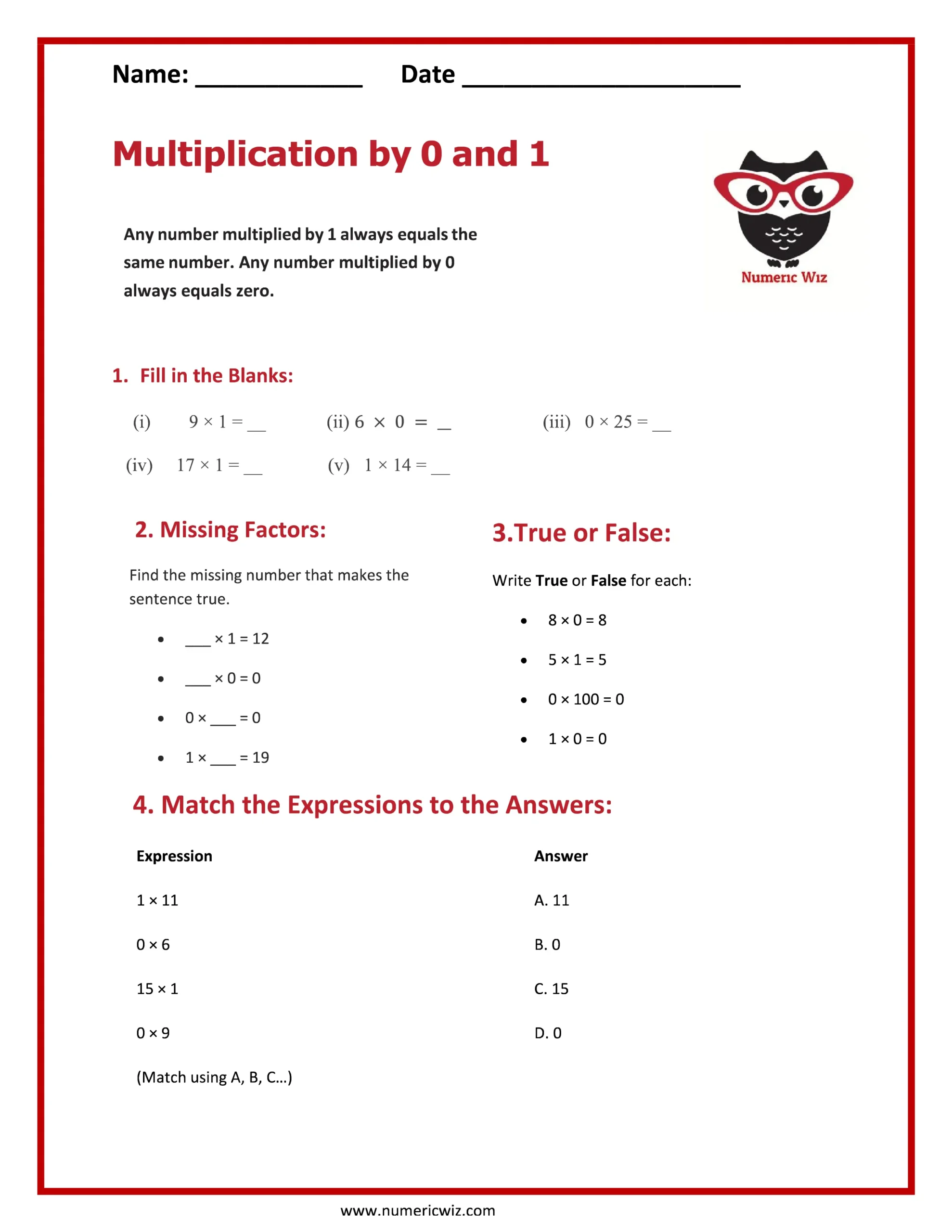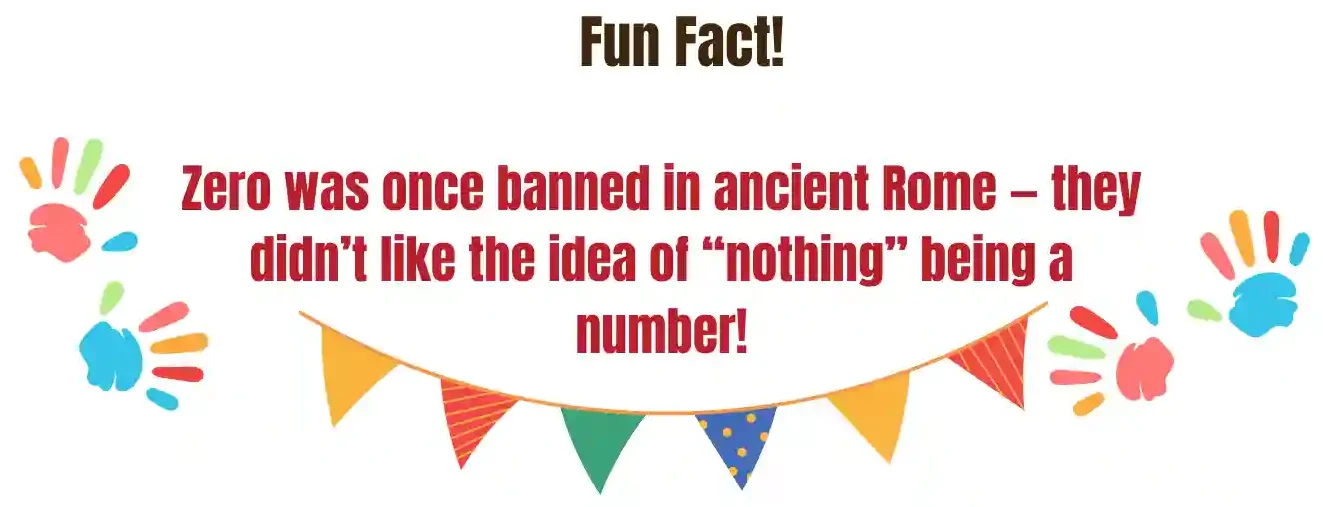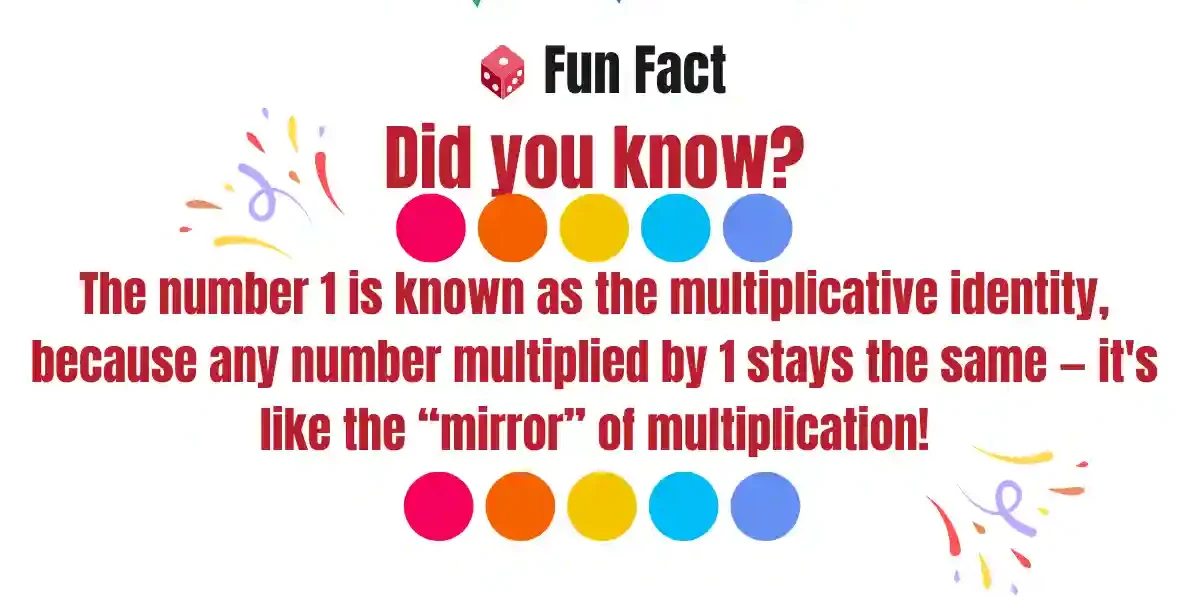Understand and apply multiplication by 0 and 1
Identify number patterns and rules
Build confidence with basic multiplication facts
Practice logical thinking through matching and true/false formats
Strengthen skills for more advanced multiplication and division topics

Have you ever looked at a math problem like 6 × 0 or 9 × 1 and thought, “That looks too easy—what’s the catch?”
You’re not alone! Many students find it confusing at first. It almost feels strange that something as small as 0 or 1 can change the whole answer.

This worksheet is here to help you see what’s really happening when we multiply by zero or one. Using visual math models and hands-on examples, we’ll explore two powerful rules in math — the Zero Property of Multiplication and the Identity Property of Multiplication. Once you understand these, you’ll never get confused again!
Let’s start simple.
When you multiply numbers, you’re really just adding the same number again and again.
But what happens when you multiply by 0 or 1?
Multiplying by 0:
Anything multiplied by 0 will always be 0.
Why? Because you have zero groups of that number — nothing to count!
Example: 8 × 0 = 0
This rule is called the Zero Property of Multiplication.
Multiplying by 1:
When you multiply by 1, your number stays exactly the same.
Why? Because you have one full group of that number — nothing added, nothing lost.
Example: 7 × 1 = 7
This is known as the Identity Property of Multiplication.
These two ideas are part of what we call the properties of multiplication — the building blocks of every math skill you’ll learn later.
Problem:
Ali has 4 baskets, and each one has 0 apples. How many apples does Ali have?
Solution:
4 × 0 = 0
Ali has no apples at all — because there are zero apples in each basket!
Now another one:
Sara has 1 bag with 9 candies.
1 × 9 = 9
Sara still has 9 candies, because multiplying by 1 keeps the number the same.
Simple, right? That’s the power of these two rules — they make math easier when you understand the logic behind them.
You might think, “Okay, I get it, 7 × 0 = 0 — but why do I need this?”
Because these rules are everywhere — in real life, in coding, and even in advanced math later on.
Think about it:
If you buy 0 items at a store, you spend $0.
If you multiply a game score by 1, it stays the same.
In computer programs, multiplying by 0 or 1 often decides whether something “turns off” or “stays on.”
Learning the zero and identity properties of multiplication helps you build real number sense — understanding how math works, not just memorizing it.
This topic connects perfectly with 3rd Grade Math Standards (3.OA.B.5).
You’re learning to understand and explain why:
Any number multiplied by 0 equals 0
Any number multiplied by 1 stays the same
You’re not just memorizing facts — you’re learning why they work, which helps you later when solving harder problems like distributive property, division, or algebraic reasoning.
Step 1: Spot the Numbers
Find the two numbers you’re multiplying.
Example: 5 × 0 → the factors are 5 and 0.
Step 2: Visualize the Problem
Use counters, blocks, or draw circles.
For 5 × 0, make 5 groups with 0 things in each — nothing there, so total = 0.
For 5 × 1, make 5 groups with 1 thing in each — total = 5.
Step 3: Notice the Pattern
Every time one factor is 0 → the answer is 0.
Every time one factor is 1 → the answer is the same as the other number.
Step 4: Explain It in Your Own Words
If you have zero groups, you have nothing.
If you have one group, you have what you started with.
That’s it!
Step 5: Practice the Pattern
Try these on your own:
6 × 0 = ?
9 × 1 = ?
12 × 0 = ?
15 × 1 = ?
See if you can explain why each one works — not just what the answer is.
This worksheet starts off easy, showing pictures and guided examples so you can see what’s happening.
Then, little by little, you’ll move to harder examples where you explain your reasoning.
By the end, you’ll even make your own examples — maybe “10 × 0 = ?” or “x × 1 = ?”.
This step-by-step approach helps build strong math confidence and makes learning fun.
Example 1:
6 × 0 = 0
If you have 6 bags with 0 apples each, you have none.
Example 2:
9 × 1 = 9
If you have 9 marbles in 1 group, you still have 9.
Example 3:
0 × 12 = 0
No groups = no objects.
Example 4 (Real-Life Story):
A bakery makes 0 cakes each day for 10 days.
10 × 0 = 0
Total cakes made? Zero. Because nothing times ten is still nothing.
You’ll be surprised how often you use these rules without even thinking about it!
Shopping: Buying 0 items means spending $0.
Electricity: 0 lights turned on = 0 energy used.
Games: If you score 1 point per round, you add the same number every time.
Coding: Setting a value to 0 resets it; multiplying by 1 keeps it unchanged.
Inventory: 3 shelves × 0 boxes = 0 items in stock.
So next time you see 0 or 1 in a problem, remember—they’re not small numbers, they’re powerful shortcuts!
Now it’s time to test what you’ve learned.
Download the worksheet and try out the problems.
Use drawings, blocks, or even coins to model what happens when you multiply by 0 or 1.
See if you can explain each answer in your own words:
Why does multiplying by 0 make everything disappear?
Why does multiplying by 1 keep it the same?
Once you can answer those, you’ve truly understood multiplication — not just memorized it!
Think you’ve cracked it?
Download the worksheet, solve it, and upload your answers to our “Evaluate Your Work” page. Our awesome teachers will check it and send feedback just for you! Homework has never been this fun—or this helpful!
Make learning meaningful with this classroom-ready worksheet — available now at NumericWiz.com.
For a limited time
